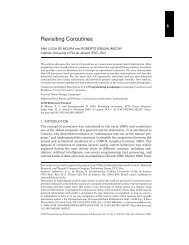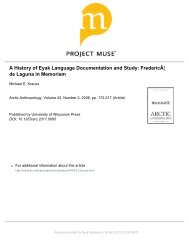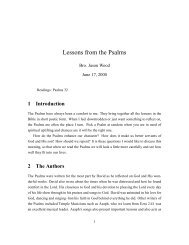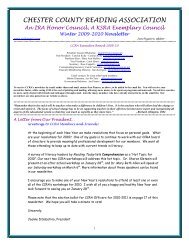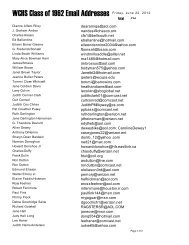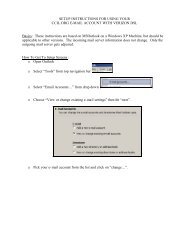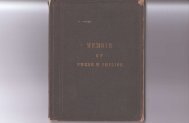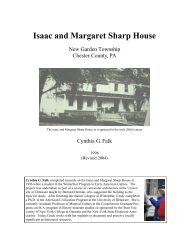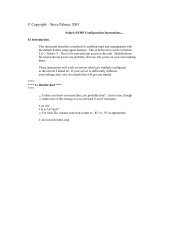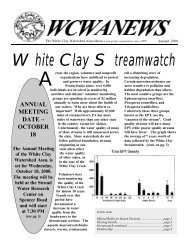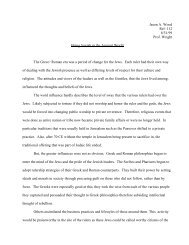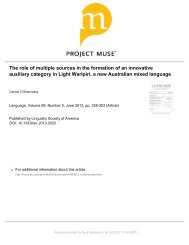Create successful ePaper yourself
Turn your PDF publications into a flip-book with our unique Google optimized e-Paper software.
in 1924. Schmidt kept most of Lepsius’s symbols,<br />
adding some diacritics to distinguish sounds left<br />
undifferentiated by Lepsius, but introduced the IPA<br />
symbols , (and turned versions of them)<br />
and , mostly to replace symbols with diacritics.<br />
For the consonants, to give some examples, < > and<br />
are used for the dental fricatives instead of<br />
Lepsius’s and , and in Schmidt’s revised<br />
edition the inverted forms of , , and <br />
replaced Lepsius’s click symbols , , and .<br />
Interestingly, the 1989 revision of the IPA alphabet<br />
adopted Lepsius’s click symbols (slightly modified).<br />
Native American Languages<br />
In 1916, the Smithsonian Institution published a<br />
pamphlet entitled <strong>Phonetic</strong> transcription of Indian<br />
languages, embodying the report of the committee<br />
of the American Anthropological Association, consisting<br />
of Franz Boas (see Boas, Franz (1858–1942)),<br />
P. E. Goddard, Edward Sapir (see Sapir, Edward<br />
(1884–1939)), and A. L. Kroeber (see Kroeber, Alfred<br />
Louis (1876–1960)). The report took as a basis the<br />
alphabet used by J. W. Powell in Contributions to<br />
North American ethnology (vol. 3, 1877). In 15<br />
pages, the pamphlet sets out general principles of<br />
transcription and rules for both a simpler and a<br />
more complete system. The principles closely resemble<br />
those of the IPA, concerning the use of the same<br />
symbol when the same sound occurs, the restrictions<br />
on the use of diacritics, the harmonizing of fonts, and<br />
the use of symbols for sound values like those that<br />
they customarily stand for. The simpler system is<br />
suggested for ‘‘ordinary purposes of recording and<br />
printing texts,’’ and the complete system is for the<br />
recording and discussing of complex and varied phonetic<br />
phenomena by specialists in phonetics. The full<br />
system of vowels is based on Sweet’s 36-vowel system<br />
(excluding the ‘shifted’ vowels of his final system).<br />
Sweet’s ‘wide’ vowels are normally shown by Greek<br />
letters, and ‘narrow’ ones by Roman letters. The consonant<br />
symbols and prosodic marks are not very different<br />
from those of the IPA; some exceptions are that<br />
small capitals are used for voiceless liquids and<br />
nasals, and also for stops and fricatives said to be<br />
‘intermediate’ between surd (voiceless) and sonant<br />
(voiced). These include unaspirated voiceless stops.<br />
The total system is a sophisticated one, providing<br />
both a high degree of precision in transcribing the<br />
detailed features of Native American languages and<br />
a satisfactory, simple form for nonspecialists.<br />
Jörgen Forchhammer’s Weltlautschrift<br />
(World Sound Notation)<br />
Forchhammer’s ‘World sound notation’ was published<br />
in Die Grundlage der Phonetik (Heidelberg,<br />
1924). It comprises a basic set of 44 Lautgruppen<br />
(sound groups, made up of 13 vowels and 31 consonants),<br />
each comprising a set of sounds that can be<br />
represented by the same letter. The nuances within<br />
each group can be shown by the wide range of diacritics,<br />
which include subscript numerals to indicate<br />
successive points of tongue contact along the palate.<br />
Of the 44 basic symbols, 36 are identical with IPA<br />
symbols, but the diacritics are mostly different (see<br />
also Heepe, 1983).<br />
The Copenhagen Conference<br />
<strong>Phonetic</strong> <strong>Transcription</strong>: <strong>History</strong> 409<br />
In April, 1925, a conference was held in Copenhagen,<br />
convened by Otto Jespersen and attended by an international<br />
group of 12 specialists in different language<br />
groups, to try to establish a norm for a universal<br />
phonetic script. Their proposals, published in 1926<br />
in <strong>Phonetic</strong> transcription and transliteration, were<br />
reprinted in 1983 (Heepe, 1983). The Copenhagen<br />
group firmly rejected the possibility of further iconic<br />
alphabets and approved the notion of ‘broad’ transcriptions<br />
based on the phoneme. Their detailed proposals<br />
for symbols were given a somewhat cool<br />
reception by the Council of the IPA (as reported in<br />
Le Maître Phonétique in 1927), but the following<br />
protocols were accepted:<br />
1. [j b] for the bilabial fricatives (instead of [F V])<br />
2. [o] for labialization<br />
3. [< B 0 U 8 §] for the retroflex series (following<br />
Lundell)<br />
4. a raised period [ � ] to show length<br />
5. vertical stress marks ["] and [%] instead of the<br />
oblique [B].<br />
Other proposals (rejected or previously adopted by<br />
the IPA) included a reversed comma below the letter<br />
for nasalization; a new diacritic for palatals; [d] for<br />
the voiced dental fricative; [x X] for velar fricatives;<br />
[K G N R L] for uvular stops, nasal, trill, and lateral and<br />
[X G] for uvular fricatives; [ O ] for glottal stop; and [ D ]<br />
as a diacritic for clicks. Among the suggestions for the<br />
vowels were abandoning the use of [a] and [A] to<br />
signify different vowels, use of superscript [ . ] for central<br />
vowels, and umlaut for front rounded vowels,<br />
e.g., [ü ö].<br />
Figure 6 The most current symbol chart of the International <strong>Phonetic</strong> Association. Reprinted from the International <strong>Phonetic</strong><br />
Association (1999) (the Department of Theoretical and Applied Linguistics, School of English, Aristotle University of Thessaloniki,<br />
Thessaloniki, Greece), with permission.



